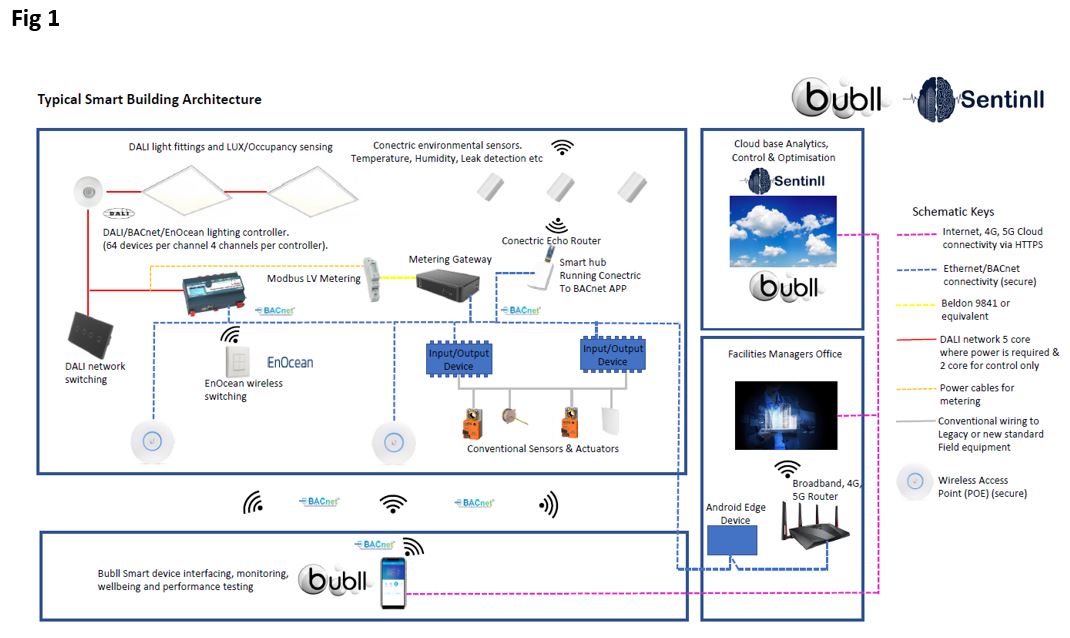|
April 2020
AutomatedBuildings.com
|
[an error occurred while processing this directive]
(Click
Message to Learn More)
|
Talking Today's Tools in the UK
These tools will transcend
BMS and Analytics
platforms incorporating the best elements of other industry platforms
and provide System Integrators and end-users with levels of
flexibility, power and visibility that the industry will ultimately
come to see as an expectation.
|

Dave Lapsley,
Managing Director
Econowise
Group of Companies
|
If
ever there has been a more poignant time
to take a closer and more serious look at the modern tools at our
disposal to homogenise building automation, then I was either asleep or
had not yet been born into this world.
Whilst I
think that we have tried to keep a positive outlook on recent events,
it is becoming more and more evident that we are in the grips of a
worldwide epidemic that requires drastic and unified action even to
begin to restore normality.
I do not have finite information on the response
to COVID-19 from the rest of the world, but in the UK, employees are
instructed to work from home. We see events that those members
tell me of the community that are of the age to remember are striking
similarities with that of when the UK and allied forces were last at
war.
Many of you may well have seen one of my recent
LinkedIn post stating that what we see over the last ten days is akin
to complete hysteria and perhaps even madness.
The number of building owners, management
companies and occupiers trying to ensure remote connectivity to their
buildings automation systems in the light of what looks to be a mass
exodus from all UK properties (other than residential) is astounding.
If the current situation that we collectively
face is not a catalyst to the dawn of a new way of working, then
nothing will be.
With communication between colleagues,
friends or family members to either provide or be updated on most
matters, 9 out of 10 times we use our mobile phones or smart devices
and that in reality, this should also be the case for Real Estate!
I would like to think that I keep myself
relatively well informed with other industry professionals' opinions
and some I agree with and some I do not.
It is more than fair to say that in the main
opinions from the automation industry, at least the ones typically
voiced are driven by allegiances to products and brands and are not
always reflective of possibilities but rather an individual
organisation's capabilities.
Holistically as an Industry, we have to stop
thinking we are in a race and focus on what we are trying to achieve.
Our end goal should be to continually evolve in providing systems that
are universal enablers in educating end-users by providing the
information that they require most fluidly and simply possible.
One typical argument that currently rages is
that surrounding wireless or wired. Should wireless replace wired and
have we all been backing the wrong horse with the widespread adoption
of Ethernet or IP based controls?
I have no real allegiance to either, but
replacing one with the other to me is neither a sensible nor viable
option as they each bring their own individual merits capabilities and
subsequent benefits to the party.
Again, here I am thinking of the word
interoperable; wireless and wired must be interoperable and homogenised
into single systems allowing their respective advantages to be
leveraged in providing platforms that offer the collective benefits and
freedom of choice that this will provide end-users.
Another topic that is currently seeing a lot of
exposure is the languages that we as an industry should be used to make
all of this work, and it seems that the forerunner for this job is Java
and its associated scripts as to quote "it is a universal platform."
Well, you may well have guessed it, but coding
is not one of my strongest attributes. Still, I am relatively lucky to
have a friend and business partner in Gurmeet Singla who has an
excellent understanding of this domain that is, in my opinion, above
all others that I have met in the automation industry.
To reference the inimitable Mr. Singla "to
attempt to leverage a single language in producing best in class
platforms would be much like trying to produce a top-class car by
taking a Ferrari engine and surrounding it with a wooden box with a
wheel on each corner." We simply wouldn't do it.
In short, every choice at every level in
the architecture has considerable importance and relevance and
decisions to be made very carefully to achieve the required
functionality whilst avoiding consequential failure.
There is one central and overarching requirement
in ensuring that products provide the essential simplicity and ultimate
functionality—the combination of domain knowledge from both automation
and software industries.
We have to face reality here. How many top-class
BMS specialists are top-class Coders, and how many top-class Coders are
top class BMS specialists? The honest answer is that they may be out
there, but for the time being, they are busy tending their Unicorns.
The undeniable fact is that the solution is, as
the title suggests, modern tools and techniques that amalgamate the
skill sets of Coders and BMS specialists and, in doing so, provide user
simplicity combined with the required functionality.
A second point that we should perhaps touch on
here as it does have colossal relevance is that surrounding the cost to
employ a BMS specialist to
modify or optimise strategy when changes are required, and the
associated costs are restrictive.
The truth in this is we are not changing
anything if coding becomes the ipso facto; we are transferring the
responsibility of the job to an even more costly asset.
The finite answer is the use of microservices
when deciding on system architecture, which is a topic best left for
another day.
History tells us that revolutionary changes are
always without fail brought to bare for a straightforward reason. They
make all of our lives easier.
A good example here is Microsoft and the
evolution of their undeniably simple to use operating system and
products.
The technology that sits underneath the
Microsoft product range has a complexity that is undoubtedly beyond
most of our understanding. Yet, it would be fair to say that pretty
much 100% of us can leverage the power of a suite of tools to produce
great results that can be understood and interpreted by all on
commonplace and, more importantly, standard computing devices.
Vast networks of standard computing devices
configured to offer seamless interaction with the information compiled
on one device easily interpreted and edited on another machine with
complete transparency.
The answer is both undeniable and
straightforward, we as a profession require a Microsoft Office suite
for the Building Automation industry that leverages state of the art
coding in simplifying the process of making Real Estate smart and
easily adaptable irrespective of local or remote locations.
[an error occurred while processing this directive]To accommodate this, our idea of system
architecture will change. Still, the results offered will bring about
the real disruption that will lead to a total revolution of the way we
all think and ultimately work.
The architecture will be an amalgamation of
devices, both wired and wireless, to augment and complement each other
without the conventional constraints that we currently endure.
Revised system architecture with modern
cutting-edge tools like Bubll & Sentinll developed with intimate
knowledge of both automation and software domains can provide levels of
functionality hard to match in terms of ease of use, performance and
flexibility.
These tools will transcend BMS and Analytics
platforms incorporating the best elements of other industry platforms
and provide System Integrators and end-users with levels of
flexibility, power and visibility that the industry will ultimately
come to see as an expectation.
FDD, Analytics and control algorithm
optimisation based upon environmental conditions, plant operational
performance and occupant feedback data harnessed to allow finite
learning and subsequent control established from standard interfaces
and smart devices.
Although by no means necessary, I believe that
although the technology is there and available to control strategy on
edge or in the cloud, it will remain in the controller for the time
being. Still, it is purely a matter of time before the edge, and
cloud-based control becomes accepted within our industry. Right or
wrong, I am not even going to begin to hypothesise on this.
These platforms will allow users the ability to
create an overarching strategy to modify system operation that will run
in tandem with that embedded on the controllers.
Changes to system operation no longer require
Coding or BMS specialists to visit the site, well-educated engineering
professionals from the built environment domain can finally be enabled
via intuitive interfaces to make educated changes based upon finite
data collected by the tools.
Once confidence grows and technologies
understood by the industry, the shackles put in place by current
thinking will be removed and convention re-written.
Site-based hardware will become no more than a
commodity. If one manufacturer's part is not available or their recent
cost increases are not to ours or our client's liking, we will select
another and replacement will require the new put in place of the old.
No strategy will mean just that. Manufacturers
will ultimately predefine inputs and outputs; the hardware will become
dumb as well as cheaper, information read and outputs written
irrespective of whether the technology is wireless or wired. The
strategy will be at the edge or in the cloud, possibilities and choices
will be endless.
Completely agnostic of the manufacturer; replace
the hardware and the system will simply start working again—no software
to change, update or modify irrespective of end-user choice.
A typical example of this revised
architecture in diagram Fig 1:
 Fig 1
Fig 1
Our industry
is going to undergo significant change. Today's tools will enable the
industry deliver current goals to provide a sustainable future and
ensure appropriate measures in reacting to any emergency in the future.
footer
[an error occurred while processing this directive]
[Click Banner To Learn More]
[Home Page] [The
Automator] [About] [Subscribe
] [Contact
Us]